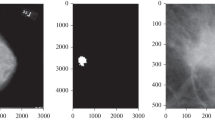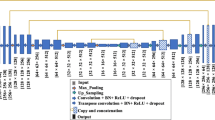Abstract
Mammography is one of the most effective tools radiologists use to detect breast cancer early, as it can detect cancer up to ten years before it manifests. The accuracy of breast cancer segmentation using computer aided design (CAD) systems is challenged by several factors, such as insufficient data for model training and data complexity. For example, mammography images are symmetrical by nature and appear complex to computer vision models, making accurate segmentation difficult. Data augmentation techniques are employed by researchers to help computer vision models preserve the invariance and equivariance features of transformed input images. However, these techniques have been insufficient and incur a computational cost. To improve the data efficiency of the computer vision models, this study proposes a model that combines the functionalities of the Mask Region Convolutional Neural Networks (Mask-RCNN) and Group Convolutional Neural Networks (GCNN) to provide highly accurate breast cancer segmentation. The GCNN preserves the invariant rotation of the transformed mammography images, increases weight sharing and the expressive capacity of the model, and minimizes computational costs. Our proposed model was applied to two mammography datasets, INbreast and MIAS. It achieved competitive results in terms of accuracy, Dice coefficient, Jaccard index, specificity, and sensitivity of 99.01%, 86.63%, 87.76%, 99.24%, and 98.55%, respectively, compared to conventional architectures.








Similar content being viewed by others
Data availability
The data supporting the findings of the study are freely available at https://www.kaggle.com/ (Subramanian 2021; Scott 2018).
References
Adedigba AP, Adeshina SA, Aibinu AM (2022) Performance evaluation of deep learning models on mammogram classification using small dataset. Bioengineering 9(4):161–170. https://doi.org/10.3390/bioengineering9040161
Andreia J, Catarino P, Doutora P, Silva S, Papanikolaou N (2022) End-to-end deep learning pipeline for breast cancer detection, segmentation and classification in contrast-enhanced spectral mammography
Benton G, Finzi M, Izmailov P, Wilson AG (2020) Learning invariances in neural networks. Adv Neural Inf Process Syst 2020(4):17605–17616. https://dl.acm.org/doi/abs/10.5555/3495724.3497201
Chidester B, Zhou T, Do MN, Ma J (2019) Rotation equivariant and invariant neural networks for microscopy image analysis. Bioinformatics 35(14):i530–i537. https://doi.org/10.1093/bioinformatics/btz353
Chiou E, Giganti F, Punwani S, Kokkinos I, Panagiotaki E (2020) Harnessing uncertainty in domain adaptation for mri prostate lesion segmentation. Lect. Notes Comput. Sci. (including Subser. Lect. Notes Artif. Intell. Lect. Notes Bioinformatics), vol 12261 LNCS, no. October, pp 510–520. https://doi.org/10.1007/978-3-030-59710-8_50
Cohen TS, Welling M (2016) Group equivariant convolutional networks. In: 33rd Int. Conf. Mach. Learn. ICML 2016, vol 6, pp 4375–4386
Cohen TS, Welling M (2017) Steerable CNNs. In: 5th Int. Conf. Learn. Represent. ICLR 2017 - Conf. Track Proc., no 1990, pp 1–14
D’Amario V, Srivastava S, Sasaki T, Boix X (2022) The data efficiency of deep learning is degraded by unnecessary input dimensions. Front Comput Neurosci 16. https://www.frontiersin.org/article/10.3389/fncom.2022.760085
Deng LF-FJ, Dong W, Socher R, Li L, Li K (2009) Imagenet: a large-scale hierarchical image database. In: 2009 IEEE conference on computer vision and pattern recognition, pp 248–255
Dieleman S, De Fauw J, Kavukcuoglu K (2016) Exploiting cyclic symmetry in convolutional neural networks. In: 33rd Int Conf Mach Learn ICML 2016, vol 4, pp 2799–2808
Erik T (2019) Metrics to evaluate your semantic segmentation model. Towards Data Science. https://link.medium.com/egbNWV0xsxb. Accessed 16 Feb 2023
Esteves C (2020) Theoretical aspects of group equivariant neural networks. http://arxiv.org/abs/2004.05154
Gaona YJ, Rodríguez-Álvarez MJ, Freire J, Castillo D, Lakshminarayanan V (2021) Fast filters for preprocessing and mass segmentation in mammography images. p 42. https://doi.org/10.1117/12.2593939
Hugo Larochelle YB, Erhan D, Courville A, Bergstra J (2007) An empirical evaluation of deep architectures on problems with many factors of variation. In: Twenty-fourth international conference on machine learning (ICML 2007), pp 1–23. http://www.machinelearning.org/proceedings/%0AIcml2007/papers/331.pdf
Jiancheng RCA, Yu H, Bai R, Li J, Wang Y (2022) Detection and segmentation of breast masses based on multi-layer feature fusion. Methods 202:54–61. https://doi.org/10.1016/j.ymeth.2021.04.022
Khan TM, Robles-Kelly A, Naqvi SS (2022) T-Net: a resource-constrained tiny convolutional neural network for medical image segmentation. In: Proc. - 2022 IEEE/CVF Winter Conf. Appl. Comput. Vision, WACV 2022, pp 1799–1808. https://doi.org/10.1109/WACV51458.2022.00186
Kolchev A, Pasynkov D, Egoshin I, Kliouchkin I, Pasynkova O, Tumakov D (2022) YOLOv4-based CNN model versus nested contours algorithm in the suspicious lesion detection on the mammography image: a direct comparison in the real clinical settings. J Imaging 8(4):88. https://doi.org/10.3390/jimaging8040088
Kraus OZ, Ba JL, Frey BJ (2016) Classifying and segmenting microscopy images with deep multiple instance learning. Bioinformatics 32(12):i52–i59. https://doi.org/10.1093/bioinformatics/btw252
Kumar P, Kumar A, Srivastava S, Padma Sai Y (2022) A novel bi-modal extended Huber loss function based refined mask RCNN approach for automatic multi instance detection and localization of breast cancer. Proc Inst Mech Eng Part H J Eng Med 236(7):1036–1053. https://doi.org/10.1177/09544119221095416
Lafarge MW, Bekkers EJ, Pluim JPW, Duits R, Veta M (2021) Roto-translation equivariant convolutional networks: application to histopathology image analysis. Med Image Anal 68:101849. https://doi.org/10.1016/j.media.2020.101849
Lee RS, Gimenez F, Hoogi A, Miyake KK, Gorovoy M, Rubin DL (2017) A curated mammography data set for use in computer-aided detection and diagnosis research. Sci Data 4(1):170177. https://doi.org/10.1038/sdata.2017.177
Liu R, Lauze F, Bekkers E, Erleben Kenny K, Darkner S (2022) Group convolutional neural networks for DWI segmentation. Proc Mach Learn Res 1(17290):1–11
Mendes J, Domingues J, Aidos H, Garcia N, Matela N (2022) AI in breast cancer imaging: a survey of different applications. J Imaging 8(9):228. https://doi.org/10.3390/jimaging8090228
Mobark N, Hamad S, Rida SZ (2022) CoroNet: deep neural network-based end-to-end training for breast cancer diagnosis. Appl Sci 12(14):7080. https://doi.org/10.3390/app12147080
Moreira IC, Amaral I, Domingues I, Cardoso A, Cardoso MJ, Cardoso JS (2012) INbreast: toward a full-field digital mammographic database. Acad Radiol 19(2):236–248. https://doi.org/10.1016/j.acra.2011.09.014
Motyka T (2022) Learned equivariance in convolutional neural networks. Delft University of Technology
Nassif AB, Talib MA, Nasir Q, Afadar Y, Elgendy O (2022) Breast cancer detection using artificial intelligence techniques: a systematic literature review. Artif Intell Med 127(October 2021):102276. https://doi.org/10.1016/j.artmed.2022.102276
Oyelade ON, Ezugwu AE (2021) A deep learning model using data augmentation for detection of architectural distortion in whole and patches of images. Biomed Signal Process Control 65(October 2020):102366. https://doi.org/10.1016/j.bspc.2020.102366
Ramesh S, Sasikala S, Gomathi S, Geetha V, Anbumani V (2022) Segmentation and classification of breast cancer using novel deep learning architecture. Neural Comput Appl 34(19):16533–16545. https://doi.org/10.1007/s00521-022-07230-4
Ranjbarzadeh R, Dorosti S, Ghoushchi SJ, Caputo A, Tirkolaee EB, Ali SS, Arshadi Z, Bendechache M (2023) Breast tumor localization and segmentation using machine learning techniques: overview of datasets, findings, and methods. Comput Biol Med. https://doi.org/10.1016/j.compbiomed.2022.106443
Ravanbakhsh S, Schneider J, Poczos B (2017) Equivariance through parameter-sharing. In: 34th Int. Conf. Mach. Learn. ICML 2017, vol 6, pp 4416–4428
Reiazi R, Paydar R, Ardakani AA, Etedadialiabadi M (2018) Mammography lesion detection using faster R-CNN detector, pp 111–115. https://doi.org/10.5121/csit.2018.80212
Romero DW, Bekkers EJ, Tomczak JM, Hoogendoorn M (2022) Attentive group equivariant convolutional networks. In: ICML’20: proceedings of the 37th international conference on machine learning, no 2016, pp 8188–8199. https://dl.acm.org/doi/10.5555/3524938.3525696
Sani Z (2023) Breast cancer classification using equivariance transition in group convolutional neural networks. IEEE Access 11(February):28454–28465. https://doi.org/10.1109/ACCESS.2023.3253640
Scott MK (2018) MIAS Mammography. https://www.kaggle.com/datasets/kmader/mias-mammography. Accessed 20 Sep 2022
Soltani H, Amroune M, Bendib I, Haouam MY (2021) Breast cancer lesion detection and segmentation based on mask R-CNn. In: Proc 2021 IEEE Int Conf Recent Adv Math Informatics, ICRAMI 2021. https://doi.org/10.1109/ICRAMI52622.2021.9585913
Subramanian R (2021) INbreast. https://www.kaggle.com/datasets/ramanathansp20/inbreast-dataset. Accessed 7 Jul 2022
Sun L, Sun H, Wang J, Wu S, Zhao Y, Xu Y (2021) Breast mass detection in mammography based on image template matching and cnn. Sensors 21(8):1–16. https://doi.org/10.3390/s21082855
Ulicny M, Krylov VA, Dahyot R (2022) Harmonic convolutional networks based on discrete cosine transform. Pattern Recognit 129:108707. https://doi.org/10.1016/j.patcog.2022.108707
Wang G et al (2021) A deep-learning pipeline for the diagnosis and discrimination of viral, non-viral and COVID-19 pneumonia from chest X-ray images. Nat Biomed Eng 5(6):509–521. https://doi.org/10.1038/s41551-021-00704-1
Weiler M, Hamprecht FA, Storath M (2018) Learning steerable filters for rotation equivariant CNNs. Proc IEEE Comput Soc Conf Comput vis Pattern Recognit. 48(1):849–858. https://doi.org/10.1109/CVPR.2018.00095
Winkels M, Cohen TS (2019) Pulmonary nodule detection in CT scans with equivariant CNNs. Med Image Anal 55:15–26. https://doi.org/10.1016/j.media.2019.03.010
Worrall DE, Garbin SJ, Turmukhambetov D, Brostow GJ (2017) Harmonic deep: Networks translation and rotation equivariance. In: Proc - 30th IEEE Conf Comput Vis Pattern Recognition, CVPR 2017, vol 2017, pp 7168–7177. https://doi.org/10.1109/CVPR.2017.758
Wu Y, Kirillov A, Massa F, G. Ross, Lo W-Y, Girshick R (2019) Detectron2. [Online]. https://github.com/facebookresearch/detectron2
Zebari DA et al (2021) Systematic review of computing approaches for breast cancer detection based computer aided diagnosis using mammogram images. Appl Artif Intell 35(15):2157–2203. https://doi.org/10.1080/08839514.2021.2001177
Zhu J, Liu M, Li X (2022) Progress on deep learning in digital pathology of breast cancer: a narrative review. Gland Surg 11(4):751–766. https://doi.org/10.21037/gs-22-11
Author information
Authors and Affiliations
Corresponding author
Ethics declarations
Conflict of interest
The authors assert that they do not have any conflicts of interest.
Additional information
Publisher's Note
Springer Nature remains neutral with regard to jurisdictional claims in published maps and institutional affiliations.
Rights and permissions
Springer Nature or its licensor (e.g. a society or other partner) holds exclusive rights to this article under a publishing agreement with the author(s) or other rightsholder(s); author self-archiving of the accepted manuscript version of this article is solely governed by the terms of such publishing agreement and applicable law.
About this article
Cite this article
Sani, Z., Prasad, R. & Hashim, E.K.M. Grouped mask region convolution neural networks for improved breast cancer segmentation in mammography images. Evolving Systems 15, 25–40 (2024). https://doi.org/10.1007/s12530-023-09527-8
Received:
Accepted:
Published:
Issue Date:
DOI: https://doi.org/10.1007/s12530-023-09527-8




